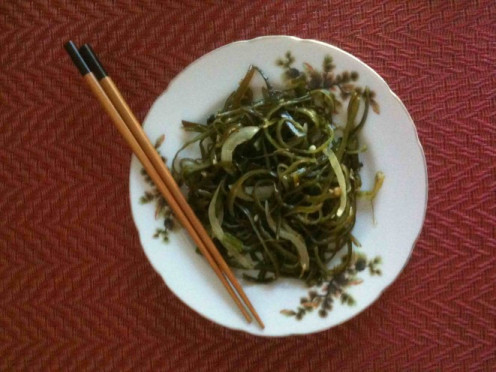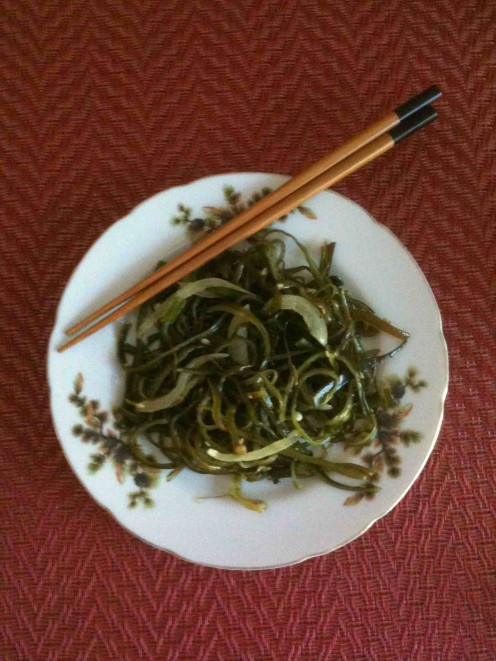Fried Seaweed Stems
There are different kinds of seaweed out there - nori, which are used for sushi rolls, hijiki, which are used in salads, wakame, kombu (or konbu in Japanese), kelp, which are used in soups like miso soup and seafood soup, and salted seaweed stems, which are used in salads. All of these types of seaweed can be used to make delicious soup, salad, sushi, and other recipes. Not only are they rich in iodine but they also taste great.
I love seaweed. Sometimes I make seaweed salad and make it from salted seaweed stems. The reason they are salted and salted a lot is so that they have a longer shelf life without spoiling. A good idea, but that means that all of that salt has to be removed prior to making the salad, otherwise it will taste over salted and inedible. So, if you ever use salted seaweed stems in your dishes make sure to rinse the seaweed really well and then soak in a bowl of water. The idea is to remove excess salt and to make sure the seaweed doesn't taste too salty when you eat it.
Besides eating seaweed salad I also love fried seaweed stems. It is a bit different than the salad but tastes even better. Making fried seaweed from salted seaweed stems can be a bit time consuming but the time spent in the kitchen is worth it because it is a very tasty dish that you'll want to eat again and again.
Below is a fried seaweed stems recipe that you are sure to love. When making this recipe just make sure that you have plenty of free time to spend in the kitchen as getting the salted seaweed stems ready for cooking is a bit time consuming as I've mentioned before.

Ingredients
- 1 package (~ 14 oz) salted seaweed stems
- 1 small onion
- 2-3 stalks scallion
- 3 cloves garlic
- cooking oil
- a few teaspoons sesame oil
- sesame seeds
- 1/4 teaspoon sugar
- salt
Instructions
- Remove the salted seaweed stems from the packaging and place into a colander. Rinse under running water to remove excess salt that's on the seaweed stems. Then place the seaweed into a large bowl, fill with water and soak for about 10 minutes. After time is up remove the water from the bowl and fill it with fresh water and soak again. You want to keep doing this until the seaweed stems are not too salty to the taste. Try them after soaking them in water a few times. When the over salty taste is gone drain the seaweed.
- The seaweed stems are very long so you have to cut them into smaller strands for easier consumption. Just use a cutting board and a knife. Some of seaweed stems may turn out to be very thick so you will have to separate them into thinner strands. When you have finished separating and cutting the seaweed stems set them aside in a large bowl. Note that this whole process can be a bit time consuming so make sure you have the patience for this step.
- Take three cloves of garlic, remove the skin, cut into tiny pieces and set aside. Then peel a small onion, cut into long slices and set aside. Finally wash two-three scallions, remove the top portion with the root, cut into slices, and set aside.
- Add some cooking oil to a skillet over medium heat. Once the skillet is hot add the garlic and cook for about 15-20 seconds, making sure that it doesn't burn. Then add the seaweed stems, mix it with the garlic and cook for about 5-6 minutes. Next add the sliced onion, and cook it for a few minutes, stirring the contents occasionally. Afterward add the scallion slices and cook for a few more minutes, stirring occasionally.
- Add about a quarter of a teaspoon of sugar, a dash of salt, and a few teaspoons of sesame oil and mix. Then add roasted sesame seeds and mix again. Cook for a few minutes and turn off the heat. Remove onto a plate and serve.
When you have finished making the fried seaweed stems serve them on a plate along with a pair of chopsticks. Chopsticks will make eating the seaweed much easier and also more fun.
If you find that people have trouble eating with chopsticks you can always offer a fork if they request it. But start off with the chopsticks first.

Fried seaweed stems make for a great appetizer. If you are a fan of seaweed you may also enjoy the following recipe:
I make both of these dishes frequently and always enjoy them. I am thinking of trying something new with seaweed stems. Will have to see what new seaweed stem creation my mind can conjure up.
Happy eating!
Do you love seaweed?
© 2012 Lena Kovadlo



